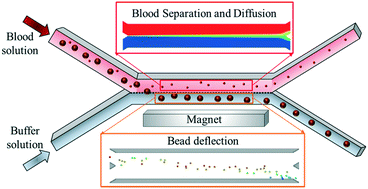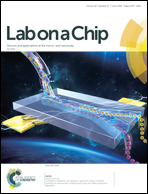Computational modeling and fluorescence microscopy characterization of a two-phase magnetophoretic microsystem for continuous-flow blood detoxification
Abstract
Magnetic beads can be functionalized to capture and separate target pathogens from blood for extracorporeal detoxification. The beads can be magnetically separated from a blood stream and collected into a coflowing buffer solution using a two-phase liquid–liquid continuous-flow microfluidic device in the presence of an external field. However, device design and process optimization, i.e. high bead recovery with minimum blood loss or dilution remain a substantial technological challenge. We introduce a CFD-based Eulerian–Lagrangian computational model that enables the rational design and optimization of such systems. The model takes into account dominant magnetic and hydrodynamic forces on the beads as well as coupled bead–fluid interactions. Fluid flow (Navier–Stokes equations) and mass transfer (Fick's law) between the coflowing fluids are solved numerically, while the magnetic force on the beads is predicted using analytical methods. The model is demonstrated via application to a prototype device and used to predict key performance metrics; degree of bead separation, flow patterns, and mass transfer, i.e. blood diffusion to the buffer phase. The impact of different process variables and parameters – flow rates, bead and magnet dimensions and fluid viscosities – on both bead recovery and blood loss or dilution is quantified for the first time. The performance of the prototype device is characterized using fluorescence microscopy and the experimental results are found to match theoretical predictions within an absolute error of 15%. While the model is demonstrated here for analysis of a detoxification device, it can be readily adapted to a broad range of magnetically-enabled microfluidic applications, e.g. bioseparation, sorting and sensing.



 Please wait while we load your content...
Please wait while we load your content...
